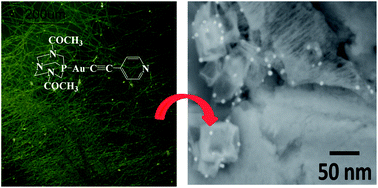The reaction of water soluble phosphine 3,7-diacetyl-1,3,7-triaza-5-phosphabicyclo[3.3.1]nonane (DAPTA) with [Au(C![[triple bond, length as m-dash]](https://www.rsc.org/images/entities/char_e002.gif) C–C5H4N)]n yields a luminescent water soluble phosphine gold(I) alkynyl complex [Au(4-pyridylethynyl)(DAPTA)] that leads to the formation of a luminescent hydrogel. A small variation of the phosphine structure (introduction of acetyl groups) with respect to the previously reported complex [Au(4-pyridylethynyl)(PTA)] has a clear effect on the observed properties: (i) a great increase in the hydrogel entanglement structure has been observed; (ii) the different cross-linking structures give rise to specific emission properties. The hydrogel was characterized by different techniques (1H-NMR, absorption and emission spectroscopy, optical microscopy, fluorescent microscopy (FM) and SEM). FM together with microspectrofluorimetry measurements has determined different emissive properties that vary according to the cross-linking process. Thermal treatments of the hydrogel produce well-defined metallic gold nanoparticles with a remarkable narrow size distribution, which have been characterized by SEM, TEM and X-ray photoelectron spectroscopy (XPS). At 200 °C, Au particles measuring 1.0 ± 0.2 nm were obtained. Au nanoparticles were also formed as a result of electron beam irradiation.
C–C5H4N)]n yields a luminescent water soluble phosphine gold(I) alkynyl complex [Au(4-pyridylethynyl)(DAPTA)] that leads to the formation of a luminescent hydrogel. A small variation of the phosphine structure (introduction of acetyl groups) with respect to the previously reported complex [Au(4-pyridylethynyl)(PTA)] has a clear effect on the observed properties: (i) a great increase in the hydrogel entanglement structure has been observed; (ii) the different cross-linking structures give rise to specific emission properties. The hydrogel was characterized by different techniques (1H-NMR, absorption and emission spectroscopy, optical microscopy, fluorescent microscopy (FM) and SEM). FM together with microspectrofluorimetry measurements has determined different emissive properties that vary according to the cross-linking process. Thermal treatments of the hydrogel produce well-defined metallic gold nanoparticles with a remarkable narrow size distribution, which have been characterized by SEM, TEM and X-ray photoelectron spectroscopy (XPS). At 200 °C, Au particles measuring 1.0 ± 0.2 nm were obtained. Au nanoparticles were also formed as a result of electron beam irradiation.

You have access to this article
 Please wait while we load your content...
Something went wrong. Try again?
Please wait while we load your content...
Something went wrong. Try again?
![[triple bond, length as m-dash]](https://www.rsc.org/images/entities/char_e002.gif) C–C5H4N)]n yields a luminescent water soluble phosphine gold(I) alkynyl complex [Au(4-pyridylethynyl)(DAPTA)] that leads to the formation of a luminescent hydrogel. A small variation of the phosphine structure (introduction of acetyl groups) with respect to the previously reported complex [Au(4-pyridylethynyl)(PTA)] has a clear effect on the observed properties: (i) a great increase in the hydrogel entanglement structure has been observed; (ii) the different cross-linking structures give rise to specific emission properties. The hydrogel was characterized by different techniques (
C–C5H4N)]n yields a luminescent water soluble phosphine gold(I) alkynyl complex [Au(4-pyridylethynyl)(DAPTA)] that leads to the formation of a luminescent hydrogel. A small variation of the phosphine structure (introduction of acetyl groups) with respect to the previously reported complex [Au(4-pyridylethynyl)(PTA)] has a clear effect on the observed properties: (i) a great increase in the hydrogel entanglement structure has been observed; (ii) the different cross-linking structures give rise to specific emission properties. The hydrogel was characterized by different techniques (

 Please wait while we load your content...
Please wait while we load your content...